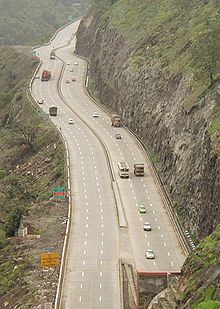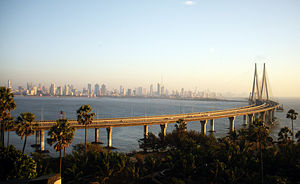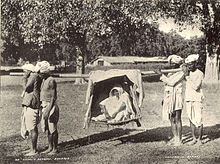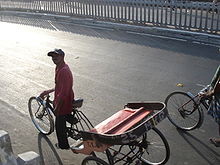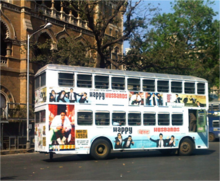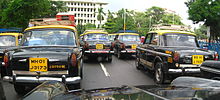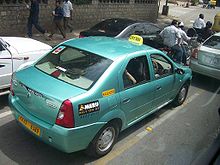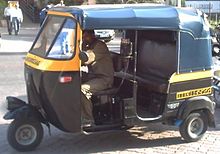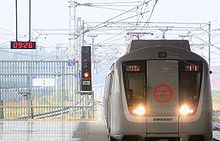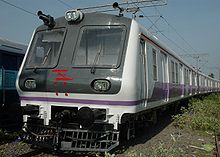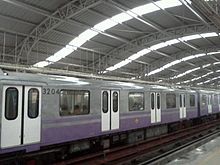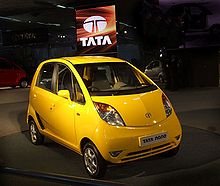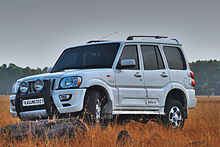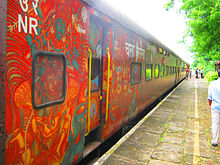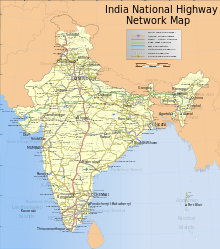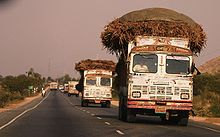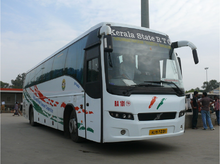- Transport in India
-
Transport in the Republic of India is an important part of the nation's economy. Since the economic liberalisation of the 1990s, development of infrastructure within the country has progressed at a rapid pace, and today there is a wide variety of modes of transport by land, water and air. However, India's relatively low GDP has meant that access to these modes of transport has not been uniform.
Motor vehicle penetration is low by international standards, with only 13 million cars on the nation's roads.[1] In addition, only around 10% of Indian households own a motorcycle.[2] At the same time, the automobile industry in India is rapidly growing with an annual production of over 2.6 million vehicles,[3] and vehicle volume is expected to rise greatly in the future.[4]
In the interim however, public transport still remains the primary mode of transport for most of the population, and India's public transport systems are among the most heavily used in the world.[5] India's rail network is the longest and fourth most heavily used system in the world, transporting over 6 billion passengers and over 350 million tons of freight annually.[5][6]
Despite ongoing improvements in the sector, several aspects of the transport sector are still riddled with problems due to outdated infrastructure, lack of investment, corruption and a burgeoning population. The demand for transport infrastructure and services has been rising by around 10% a year[5] with the current infrastructure being unable to meet these growing demands. According to recent estimates by Goldman Sachs, India will need to spend US$1.7 trillion on infrastructure projects over the next decade to boost economic growth, of which US$500 billion is budgeted to be spent during the Eleventh Five-Year Plan.[7]
Contents
Traditional means
Walking
In ancient times, people often covered long distances on foot. For instance, Adi Sankaracharya travelled all over India.[8] Walking still constitutes an important mode of transport in urban areas.[9] In the city of Mumbai, to further improve the transit conditions for pedestrians, the Mumbai Metropolitan Region Development Authority, has commenced the construction of more than 50 skywalks,[10][11] as part of the Mumbai Skywalk project. Similar Footover Bridge projects have been initiated in other cities, in an attempt to facilitate the movement of pedestrians. The concepts of zebra crossing, footpath and right of way of pedestrians are absent in many urban and semi-urban centres of India, making pedestrians highly prone to accidents and fatalities.
Palanquin
Palanquins, also known as palkis, were one of the luxurious methods used by the rich and noblemen for travelling. This was primarily used in the past to carry a deity or idol of a god, and many temples have sculptures of god being carried in a palki. Later on, it was primarily used by European noblemen and ladies from the upper classes of society prior to the advent of the railways in India.[12] Modern use of the palanquin is limited to Indian weddings.
Bullock carts and horse carriages
Bullock carts have been traditionally used for transport, especially in rural India. The arrival of the British saw drastic improvements in the horse carriages which were used for transport since early days. Today, they are used in smaller towns and are referred as Tonga or buggies. Victorias of Mumbai are still used for tourist purposes, but horse carriages are now rarely found in the metro cities of India.[13] In recent years some cities have banned the movement of bullock carts and other slow moving vehicles on the main roads.[14][15][16]
Bicycles
Bicycles are a common mode of travel in much of India. More people can now afford to own a cycle than ever before. In 2005, more than 40% of Indian households owned a bicycle, with ownership rates ranging from around 30% to 70% at the state level.[2] Along with walking, cycling accounts for 50 to 75 % of the commuter trips for those in the informal sector in urban areas.[9]
Even though India is the second largest producer of bicycles in the world,[17] a significant prejudice against bicycle riding for transport exists in some segments of the population, generally stemming from the status symbol aspect of the motor vehicle.[17] In India, the word "bike" generally refers to motorcycle, and "cycle" refers to bicycle.[17]
Pune was the first city in India to have dedicated lanes for cycles.[18] It was built for the 2008 Commonwealth Youth Games.
However, recent developments in Delhi suggest that bicycle riding is fast becoming popular in the metro cities of India. The Delhi government has decided to construct separate bicycle lanes on all major roads to combat pollution and ease traffic congestion.[19]
Hand-pulled rickshaw
This type of transport are still available in Kolkata wherein a person pulls the rickshaw by hand. The Government of West Bengal proposed a ban on these rickshaws in 2005 describing them as "inhuman".[20] Though a bill aiming to address this issue, termed as 'Calcutta Hackney Carriage Bill', was passed by the West Bengal Assembly in 2006, it has not been implemented yet.[21] The Government of West Bengal is working on an amendment of this bill to avoid the loopholes that got exposed when the Hand-pulled Rickshaw Owner's Association filed a petition against the bill.[21]
Cycle rickshaw
Cycle rickshaws were introduced into India in the 1940s.[22] They are bigger than a tricycle where two people sit on an elevated seat at the back and a person pedals from the front. In the late 2000s, they were banned in several cities for causing traffic congestion.[23][24][25] Cycle rickshaws have been a feature of Delhi streets since Indian independence in 1947, providing the cheapest way around the capital. The Delhi Police recently submitted an affidavit against plying of cycle rickshaws to ease traffic congestion in the city but it was dismissed by the Delhi High court.[26] In addition, environmentalists have supported the retention of cycle rickshaws as a non-polluting and inexpensive mode of transport.[27]
Trams
The advent of the British saw trams being introduced in many cities including Mumbai and Kolkata. They are still in use in Kolkata and provide an emission-free means of transport. The nationalized Calcutta Tramways Company is in the process of upgrading the existing tramway network at a cost of
 24 crore (US$4.87 million).[28] Presently the limited tram system in India is extremely slow and technologically backward, new light rail projects are being proposed rather than tram projects which have one reason or another not been very successful in the country
24 crore (US$4.87 million).[28] Presently the limited tram system in India is extremely slow and technologically backward, new light rail projects are being proposed rather than tram projects which have one reason or another not been very successful in the countryLocal transport
 Buses on the Delhi BRTS. Delhi was one of the first cities in India to introduce CNG powered buses. Many cities like Ahmedabad has introduced BRTS.
Buses on the Delhi BRTS. Delhi was one of the first cities in India to introduce CNG powered buses. Many cities like Ahmedabad has introduced BRTS.
Public transport is the predominant mode of motorised local travel in cities.[9] This is predominantly by road, since commuter rail services are available only in the six metropolitan cities of Mumbai, Delhi, Chennai, Bangalore, Hyderabad and Kolkata, while dedicated city bus services are known to operate in at least 25 cities with a population of over one million.[29] Intermediate public transport modes like tempos and cycle rickshaws assume importance in medium size cities.[9] However, the share of buses is negligible in most Indian cities as compared to personalized vehicles, and two-wheelers and cars account for more than 80 percent of the vehicle population in most large cities.[29]
Traffic in Indian cities generally moves slowly, where traffic jams and accidents are very common.[30] India has very poor records on road safely—around 90,000 people die from road accidents every year.[31] At least 13 people die every hour in road accidents in the country,also in the year 2007 road accidents claimed more than 130,000 lives, overtaking China.[32] [33]
A Reader's Digest study of traffic congestion in Asian cities ranked several Indian cities within the Top Ten for worst traffic.[30]
Public transport
Buses
The oldest Indian state transport under taking is "North Bengal State Transport Corporation" founded by the Raj Durbar regime in the year 1945, the 1st April.With three buses and three trucks.Is still vibrant and running providing service to hundreds of commuters of North Bengal region of West Bengal. link nbstc.co.in Buses take up over 90% of public transport in Indian cities,[34] and serve as a cheap and convenient mode of transport for all classes of society. Services are mostly run by state government owned transport corporations.[29] However, after the economic liberalisation, many state transport corporations have introduced various facilities like low-floor buses for the disabled and air-conditioned buses to attract private car owners to help decongest roads.[35][36] Bengaluru was the first city in India to introduce Volvo B7RLE intra-city buses in India in January 2006.[37][38][39]
New initiatives like Bus Rapid Transit (BRT) systems and air conditioned buses have been taken by the various state government to improve the bus public transport systems in cities. Bus Rapid Transit systems already exist in Pune, Delhi and Ahmedabad with new ones coming up in Visakhapatnam Hyderabad and Bangalore. High Capacity buses can be found in cities like Mumbai, Bengaluru, Nagpur and Chennai. Bengaluru is the first Indian city to have an air-conditioned bus stop, located near Cubbon Park. It was built by Airtel.[40] The APSRTC has introduced Buses with two coaches.These Buses are allowed to operate only in the Greater Hyderabad. The city of Chennai houses Asia's largest bus terminus, the Chennai Mofussil Bus Terminus.[41] In 2009, the Government of Karnataka and the Bangalore Metropolitan Transport Corporation flagged off a pro-poor bus service called the Atal Sarige. The service aims to provide low-cost connectivity to the economically backward sections of the society to the nearest major bus station.[42][43]
Now the Semi low floor buses are in Trivandrum city and Kerala State for comfort Travel. The first bus from the Semi-Low floor Ac & Non Ac fleet of 120 JNNURM buses started service in Trivandrum city. The buses are high standards with air suspension and quality seats for better comfort, LED boards and rear mounted engines. There will be two doors of 1100mm width, one in the front and one in middle which are controlled by driver.
This will facilitate easy entry and exit for the passengers. Semi Low floor non A/c buses are painted green (A/c buses are in Orange) will be having JNNURM and KSRTC logos.
Taxi
Main article: Taxis in IndiaMost of the traditional taxicabs in India are either Premier Padmini or Hindustan Ambassador cars.[44] In recent years, cars such as Chevrolet Tavera, Maruti Esteem, Maruti Omni, Mahindra Logan, Tata Indica, Toyota Innova, Hyundai Santro and Tata Indigo have become fairly popular among taxi operators. The livery of the taxis in India varies from state-to-state. In Delhi and Maharashtra, most taxicabs have yellow-black livery while in West Bengal, taxis have yellow livery. Private taxi operators are not required to have a specific livery. However, they are required by law to be registered as commercial vehicles.
Depending on the city/state, taxis can either be hailed or hired from taxi-stands. In cities such as Ahmedabad, Bengaluru, Hyderabad,taxis need to be hired over phone,[45] whereas in cities like Kolkata and Mumbai, taxis can be hailed on the street. According to government of India regulations, all taxis are required to have a fare-meter installed.[46] There are additional surcharges for luggage, late-night rides and toll taxes are to be paid by the passenger. Since 2006, radio taxis have become increasingly popular with the public due to reasons of safety and convenience.[47]
In cities and localities where taxis are expensive or do not ply as per the government or municipal regulated fares, people use share taxis. These are normal taxis which carry one or more passengers travelling to destinations either en route to the final destination, or near the final destination. The passengers are charged according to the number of people with different destinations. A similar system exists for autorickshaws, known as share autos.
The city of Mumbai will soon be the first city in India, to have an "in-taxi" magazine, titled MumBaee, which will be issued to taxis which are part of the Mumbai Taximen's Union. The magazine debuted on 13 July 2009.[48]
Auto Rickshaws
Main article: AutorickshawAn auto rickshaw is a three wheeler vehicle for hire that has no doors and is generally characterised by a small cabin for the driver in the front and a seat for passengers in the rear.[49] Generally it is painted in yellow, green or black colour and has a black, yellow or green canopy on the top, but designs vary considerably from place to place. The color of the autorickshaw is also determined by the fuel that it is powered by, for example Ahmedabad and Delhi have green autos indicating the use of Compressed Natural Gas, whereas the autos of Mumbai, Bangalore have black autos indicating the use of diesel.
In Mumbai and other metropolitan cities, 'autos' or 'ricks' as they are popularly known have regulated metered fares. A recent law prohibits auto rickshaw drivers from charging more than the specified fare, or charging night-fare before midnight, and also prohibits the driver from refusing to go to a particular location. Mumbai and Kolkata are also the only two cities which prohibit auto rickshaws from entering a certain part of the city, in these cases being South Mumbai and certain parts of downtown Kolkata.[50] However, in cities like Chennai, it is common to see autorickshaw drivers demand more than the specified fare and refuse to use fare meter [51]
Airports and railway stations at many cities such as Chennai, Bengaluru, Mysore and Hubballi-Dharwad provide a facility of prepaid auto booths, where the passenger pays a fixed fare as set by the authorities for various locations.[52]
Suburban Railway
The present suburban railway services in India are limited and are operational only in Mumbai, Kolkata, Chennai, Delhi and MMTS Hyderabad .[29] The Mumbai Suburban Railway is the first rail system in India which began services in Mumbai in 1867, transports 6.3 million passengers daily and has the highest passenger density in the world.[53] The first rapid transit system in India, the Kolkata Suburban Railway, was established in Kolkata in 1854.[54] Its first service ran between Howrah and Hooghly covering a distance of 38.6 km (24 mi).
Metro Rail (Mass Rapid Transit System)
Main article: Rapid transit in IndiaThe first modern rapid transit in India was the Kolkata Metro, with operations starting in 1984. Chennai MRTS acts as second urban mass transit system since 1997 and differs from country's other MRTS suburban systems. The Delhi Metro in the capital city of New Delhi is third conventional metro beginning operations in 2002.The Namma Metro in Bangalore is India's fourth operational rapid transit beginning operations in 2011. Currently, rapid transit systems have been deployed in these cities and more are under construction or in planning in several major cities of India.
Cities that have a metro system:
Metro systems under Construction
- Mumbai Metro
- Rapid Metro Rail Gurgaon
- Jaipur Metro
- Chennai Metro
- Navi Mumbai Metro
- Hyderabad Metro
- Kochi Metro
Two-wheelers
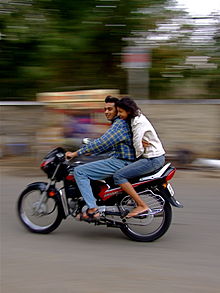 A couple ride on a motorcycle in Udaipur, India. Annual sales of motorcycles in India are expected to exceed 10 million by 2010.[55]
A couple ride on a motorcycle in Udaipur, India. Annual sales of motorcycles in India are expected to exceed 10 million by 2010.[55]
Motorised two-wheelers like scooters, small capacity motorcycles and mopeds are very popular a mode of transport due to their fuel efficiency and ease of use in congested traffic. The number of two-wheelers sold is several times that of cars. There were 4.75 crore (47.5 million) powered two wheelers in India in 2003 compared with just 86 lakh (8.6 million) cars.[56] Yamaha, Harley Davidson, Hero Honda, Honda, TVS Motors, Bajaj Auto and Mahindra 2wheeler are the largest two-wheeler companies in terms of market-share.[57] Royal Enfield, an iconic brand name in the country, manufactures different variants of the British Bullet motorcycle which is a classic motorcycle that is still in production.[58]
Manufacture of scooters in India started when Automobile Products of India (API), set up at Mumbai and incorporated in 1949, began assembling Innocenti-built Lambretta scooters in India post independence. They eventually acquired licence for the Li150 series model, of which they began full-fledged production from the early sixties onwards. In 1972, Scooters India Ltd (SIL), a state-run enterprise based in Lucknow, Uttar Pradesh, bought the entire manufacturing rights of the last Innocenti Lambretta model. API has infrastructural facilities at Mumbai, Aurangabad, and Chennai but has been non-operational since 2002. SIL stopped producing scooters in 1998.
Motorcycles and scooters can be rented in many cities. Wearing protective headgear is mandatory for both the rider and the pillion-rider in most cities.
Automobiles
Private vehicles account for 30% of the total transport demand in urban areas of India. An average of 963 new private vehicles are registered every day in Delhi alone.[59] The number of automobiles produced in India rose from 63 lakh (6.3 million) in 2002-03 to 1.1 crore (11.2 million) in 2008-09.[60] However, India still has a very low rate of car ownership. When comparing car ownership between BRIC developing countries, it is on a par with China,[56] and exceeded by Brazil and Russia.[61]
Compact cars, especially hatchbacks predominate due to affordability, fuel efficiency, congestion, and lack of parking space in most cities. Maruti, Hyundai and Tata Motors are the most popular brands in the order of their market share. The Ambassador once had a monopoly but is now an icon of pre-liberalisation India, and is still used by taxi companies. Maruti 800 launched in 1984 created the first revolution in the Indian auto sector because of its low pricing. It had the highest market share until 2004, when it was overtaken by other low cost models from Maruti such as the Alto and the Wagon R, the Indica from Tata Motors and the Santro from Hyundai. Over the 20 year period since its introduction, about 24 lakh (2.4 million) units of the Maruti 800 have been sold.[62] However, with the launch of the Tata Nano, the least expensive production car in the world,[63]
India is also known for a variety of indigenous vehicles made in villages out of simple motors and vehicle spare-parts. A few of these innovations are the Jugaad, Maruta, Chhakda, peter rehda and the Fame.[64]
In the city of Bengaluru, Radio One and the Bangalore Traffic Police, launched a carpooling drive which has involved celebrities such as Robin Uthappa, and Rahul Dravid encouraging the public to carpool.[65][66][67] The initiative got a good response, and by the end of May 2009, 10,000 people are said to have carpooled in the city.[68]
Utility vehicles
The first utility vehicle in India was manufactured by Mahindra and Mahindra. It was a copy of the original Jeep and was manufactured under licence.[69] The vehicle was an instant hit and made Mahindra one of the top companies in India. The Indian Army and police extensively use Mahindra vehicles along with Maruti Gypsys for transporting personnel and equipment.
Tata Motors, the automobile manufacturing arm of the Tata Group, launched its first utility vehicle, the Tata Sumo, in 1994.[70][71] The Sumo, owing to its then-modern design, captured a 31% share of the market within two years.[72] The Tempo trax from Force Motors till recently was ruling the rural areas. Sports utility vehicles now form a sizeable part of the passenger vehicle market.[73] Models from Tata, Honda, Hyundai, Ford, Chevrolet and other brands are available.[74]
Long distance transport
Railway
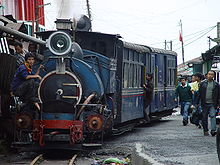 The Darjeeling Himalayan Railway is a World Heritage Site,[75] and one of the few steam engines in operation in India.
The Darjeeling Himalayan Railway is a World Heritage Site,[75] and one of the few steam engines in operation in India.
Rail services in India, first introduced in 1853, are provided by the state-run Indian Railways, under the supervision of the Ministry of Railways. Indian Railways provides an important mode of transport in India, transporting over 18 million passengers and more than 2 million tonnes of freight daily across one of the largest and busiest rail networks in the world.[76][77] By 1947, the year of India's independence, there were forty-two rail systems. In 1951 the systems were nationalised as one unit, becoming one of the largest networks in the world. Indian Railways is divided into sixteen zones, which are further sub-divided into sixty seven divisions, each having a divisional headquarters.[78][79]
The rail network traverses through the length and breadth of the country, covering 6,909 stations over a total route length of around 63,465 km (39,435 mi).[80] It is the world's largest commercial or utility employer, with more than 1.4 million employees.[76][81] As to rolling stock, IR owns over 200,000 (freight) wagons, 50,000 coaches and 8,000 locomotives.[76] It also owns locomotive and coach production facilities. It operates both long distance and suburban rail systems on a multi-gauge network of broad, metre and narrow gauges, and is in the process of converting all the metre gauge (14,406 km (8,951 mi)) into broad gauge in a project called Project Unigauge.
The Indian Railways runs a number of special types of services which are given higher priority. The Rajdhani trains introduced in 1969 provides connectivity between the national capital, Delhi and capitals of the states. On the other hand, Shatabdi Express provides connectivity between centres of tourism, pilgrimage or business. The Shatabdi Express trains run over short to medium distances while the Rajdhani Expresses run over longer distances. Both series of trains have a regular speed of 130 to 140 km/h (81 to 87 mph). The 12001 Bhopal Shatabdi express, however, runs at a peak speed of 161 km/h (100 mph), which makes it the fastest train in India. The other specialised services operated by the Railways are the Duronto Express and Garib Raths. While Duronto provides non-stop point to point rail services, Garib Rath aims to provide comfortable rail travel at an economical rate. Besides, The Indian Railways also operates a number of luxury trains which cater to various tourist circuits. For instance, the Palace on Wheels serves the Rajasthan circuit and the The Golden Chariot serves the Karnataka and Goa circuits. There are two UNESCO World Heritage Sites on IR — the Chatrapati Shivaji Terminus[82] and the Mountain railways of India. The latter is not contiguous, but actually consists of three separate railway lines located in different parts of India:[83]
- The Darjeeling Himalayan Railway, a narrow gauge railway in West Bengal.
- The Nilgiri Mountain Railway, a metre gauge railway in the Nilgiri Hills in Tamil Nadu
- The Kalka-Shimla Railway, a narrow gauge railway in the Shivalik mountains in Himachal Pradesh.
- The Maharaja Railways (Gwalior Light Railway), a narrow gauge line of just 0.6m width from Gwalior to Sheopur of 198 km. in length is world's longest narrow gauge railway line is in the UNESCO world heritage tentative list.
- The Neral-Matheran Railway, a narrow gauge railway connecting Matheran is also a historic line.
The Indian Railways has also initiated a number of highly ambitious projects to provide connectivity to the remote and inaccessible areas of the country. The Konkan Railway is one such highly difficult project undertaken by the authorities. The two important port cities of Mangalore and Mumbai were not directly connected by the railway network. Even though economic reasons provided a strong need to connect these two cities, due to the uneven terrain of the region railway lines were not laid for many years. The project was undertaken by the Indian Railways in collaboration with a number of states on the Indian Union in the late 1980s, and began operating in 1998. The line is 738 km (458.57 mi) long and consists of 2000 bridges and 91 tunnels. Another such highly ambitious project is the Kashmir Railway, which is to provide reliable strategic connectivity between the northern most state of India and the rest of the country.Kashmir Railway is the second highest in the world and against numerous challenges first phase was completed in 2009.[84]
Proposals have been made to introduce high-speed rail in India. A proposal has been made to build a Maglev track within the city of Mumbai, connecting it to the National Capital of New Delhi, as well as other parts of Maharashtra in the form of the Mumbai Maglev.[85] Another proposal has been made to introduce a High-speed rail in India similar to that of the Shinkansen of Japan.[86]
In 1999, the Konkan Railway Corporation introduced the Roll On Roll Off (RORO) service, a unique road-rail synergy system, on the section between Kolad in Maharashtra and Verna in Goa,[87] which was extended up to Surathkal in Karnataka in 2004.[88][89] The RORO service, the first of its kind in India, allowed trucks to be transported on flatbed trailers. It was highly popular,[90] carrying about 1,10,000 trucks and bringing in about
 74 crore worth of earnings to the corporation till 2007.[91]
74 crore worth of earnings to the corporation till 2007.[91]International
Rail links between India and neighbouring countries are not well-developed. Two trains operate to Pakistan - the Samjhauta Express between Delhi and Lahore, and the Thar Express between Jodhpur and Karachi. Bangladesh is connected by a bi-weekly train, the Maitree Express. Nominal rail links to Nepal exist — passenger services between Jaynagar and Bijalpura, and freight services between Raxaul and Birganj.[92]
No rail link exists at present with Myanmar, but a railway line is to be built through from Jiribam (in Manipur) to Tamu through Imphal and Moreh.[93] The construction of this missing link, as per the feasibility study conducted by the Ministry of External Affairs through RITES Ltd, is estimated to cost
 2,941 crore (US$596.43 million).[94] Rail links with Bhutan have been proposed. No rail link exists with either China or Sri Lanka,[95] however in the disputed region of Gilgit-Baltistan, the current controller of this area, Pakistan has proposed a rail link with China across the Khunjerab Pass. However, as India has been extending its railway near the Nathu La pass with China, and China has plans to extend the Qinghai-Tibet railway to near its border with Nathu La, a petition was set up to promote the idea that both countries could link up their respective proportions for direct train services between the two countries. As of 6 September 2011, the petition had 81 members.[96]
2,941 crore (US$596.43 million).[94] Rail links with Bhutan have been proposed. No rail link exists with either China or Sri Lanka,[95] however in the disputed region of Gilgit-Baltistan, the current controller of this area, Pakistan has proposed a rail link with China across the Khunjerab Pass. However, as India has been extending its railway near the Nathu La pass with China, and China has plans to extend the Qinghai-Tibet railway to near its border with Nathu La, a petition was set up to promote the idea that both countries could link up their respective proportions for direct train services between the two countries. As of 6 September 2011, the petition had 81 members.[96]Road
India has a network of National Highways connecting all the major cities and state capitals, forming the economic backbone of the country. As of 2005, India has a total of 66,590 km (41,377 mi) of National Highways, of which 200 km (124 mi) are classified as expressways.[97] Under National Highways Development Project (NHDP), work is under progress to equip some of the important national highways with four lanes; also there is a plan to convert some stretches of these roads to six lanes.[98] However congestion and bureaucratic delays enroute ensure that trucking goods from Gurgaon to the port in Mumbai can take up to 10 days.[99]
As per the National Highways Authority of India, about 65% of freight and 80% passenger traffic is carried by the roads. The National Highways carry about 40% of total road traffic, though only about 2% of the road network is covered by these roads.[97] Average growth of the number of vehicles has been around 10.16% per annum over recent years.[97] Highways have facilitated development along the route and many towns have sprung up along major highways. Road transport Benchmark Freight Index (BFI) initiative taken in India in recently by itransi.
All national highways are metalled, but very few are constructed of concrete, the most notable being the Mumbai-Pune Expressway. In recent years construction has commenced on a nationwide system of multi-lane highways, including the Golden Quadrilateral and North-South and East-West Corridors which link the largest cities in India. In 2000, around 40% of villages in India lacked access to all-weather roads and remained isolated during the monsoon season.[5][100]
To improve rural connectivity, Pradhan Mantri Gram Sadak Yojana (Prime Minister's Rural Road Program), a project funded by the Central Government with the help of World Bank, was launched in 2000 to build all-weather roads to connect all habitations with a population of 500 or above (250 or above for hilly areas).[100][101]
As per 2009 estimates, the total road length in India is 3,320,410 km (2,063,210 mi);[102] making the Indian road network the third largest road network in the world. At 0.66 km of highway per square kilometre of land the density of India’s highway network is higher than that of the United States (0.65) and far higher than that of China's (0.16) or Brazil's (0.20).[5]
Type of Road Length Expressways 650 km (400 mi) as of 2006 National Highways 66,590 km (41,380 mi) State Highways 131,899 km (81,958 mi) Major District Roads 467,763 km (290,654 mi) Rural and Other Roads 2,650,000 km (1,650,000 mi) Total Length 3,300,000 km (2,100,000 mi) (Approx) Buses are an important means of public transport in India, particularly in the countryside and remote areas where the rail network cannot be accessed and airline operations are few or non-existent. Due to this social significance, public bus transport is predominantly owned and operated by public agencies, and most state governments operate bus services through a State Road Transport Corporation.[103] These corporations, introduced in the 1960s and 1970s, have proven extremely useful in connecting villages and towns across the country.[29]
Aviation
Rapid economic growth in India has made air travel more affordable. Air India, India's flag carrier, presently operates a fleet of 159 aircraft and plays a major role in connecting India with the rest of the world.[104] Several other foreign airlines connect Indian cities with other major cities across the globe.
Kingfisher Airlines, Air India and Jet Airways are the most popular brands in domestic air travel in order of their market share.[105] These airlines connect more than 80 cities across India and also operate overseas routes after the liberalisation of Indian aviation. However, a large section of country's air transport system remains untapped, even though the Mumbai-Delhi air corridor was ranked 6th by the Official Airline Guide in 2007 among the world's busiest routes.[106]
India's vast unutilised air transport network has attracted several investments in the Indian air industry in the past few years. More than half a dozen low-cost carriers entered the Indian market in 2004-05. Major new entrants include Air Deccan, Kingfisher Airlines, SpiceJet, GoAir, Paramount Airways and IndiGo Airlines. To meet India's rapidly increasing demand for air travel, Air India recently placed orders for more than 68 jets from Boeing for US$7.5 billion while Indian placed orders for 43 jets from Airbus for US$2.5 billion.[107][108]
Jet Airways, India's largest private carrier, has invested millions of dollars to increase its fleet,[109] but this has been put on hold due to the recent economic slowdown.[110] This trend is not restricted to traditional air carriers in India. IndiGo Airlines entered the limelight when it announced orders for 100 Airbus A320s worth US$6 billion during the Paris Air Show; The highest by any Asian domestic carrier.[111] Kingfisher Airlines became the first Indian air carrier on June 15, 2005 to order Airbus A380 aircraft.[112] The total deal with Airbus was worth US$3 billion.[113]
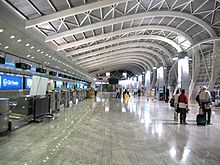 Chhatrapati Shivaji International Airport in Mumbai is currently India's busiest airport in terms of passenger traffic.[114]
Chhatrapati Shivaji International Airport in Mumbai is currently India's busiest airport in terms of passenger traffic.[114]
Airports
There are more than 335 (2008 est.)[115] civilian airports in India - 250 with paved runways and 96 with unpaved runways and more than 20 international airports in the Republic of India. The Indira Gandhi International Airport and the Chhatrapati Shivaji International Airport handle more than half of the air traffic in South Asia.[116][117][118]
 Indira Gandhi International Airport in Delhi is India's busiest in terms of the number of daily flights.[116]
Indira Gandhi International Airport in Delhi is India's busiest in terms of the number of daily flights.[116]
Length of runways Airports
with paved
runways (2008 est.)[115]Airports
with unpaved
runways (2008 est.)[115]3,047 m (9,997 ft) or more 19 0 2,438 m (7,999 ft)—3,047 m (9,997 ft) 55 1 1,524 m (5,000 ft)—2,438 m (7,999 ft) 77 7 914 m (2,999 ft)—1,524 m (5,000 ft) 84 39 Under 914 m (2,999 ft) 16 47 Total 251 94 Heliports
As of 2007, there are 30 heliports in India.[115] India also has the world's highest helipad at the Siachen Glacier a height of 6400 metre (21,000 ft) above mean sea level.[119]
Pawan Hans Helicopters Limited is a public sector company that provides helicopter services to ONGC to its off-shore locations, and also to various State Governments in India, particularly in North-east India.[120]
Ports and shipping
Maritime transportation in India is managed by the Shipping Corporation of India, a government-owned company that also manages offshore and other marine transport infrastructure in the country. It owns and operates about 35% of Indian tonnage and operates in practically all areas of shipping business servicing both national and international trades.[121]
It has a fleet of 79 ships of 27.5 lakh GT (48 lakh DWT) and also manages 53 research, survey and support vessels of 1.2 Lakh GT (0.6 Lakh DWT) on behalf of various government departments and other organisations.[122] Personnel are trained at the Maritime Training Institute in Mumbai, a branch of the World Maritime University, which was set up in 1987.[123] The Corporation also operates in Malta and Iran through joint ventures.[122]
The ports are the main centres of trade. In India about 95% of the foreign trade by quantity and 70% by value takes place through the ports.[125] Mumbai Port & JNPT(Navi Mumbai) handles 70% of maritime trade in India.[126] There are twelve major ports: Navi Mumbai, Mumbai, Kolkata (including Haldia), Paradip, Vishakapatnam, Ennore, Chennai, Tuticorin, Kochi, New Mangalore, Mormugao and Kandla.[80] Other than these, there are 187 minor and intermediate ports, 43 of which handle cargo.[80]
The distinction between major and minor ports is not based on the amount of cargo handled. The major ports are managed by port trusts which are regulated by the central government. They come under the purview of the Major Port Trusts Act, 1963. The minor ports are regulated by the respective state governments and many of these ports are private ports or captive ports. The total amount of traffic handled at the major ports in 2005-2006 was 382.33 Mt.[80]
Waterways
Main article: Inland Waterways Authority of IndiaIndia has an extensive network of inland waterways in the form of rivers, canals, backwaters and creeks. The total navigable length is 14,500 kilometers (9,000 mi), out of which about 5,200 km (3,231 mi) of river and 485 km (301 mi) of canals can be used by mechanised crafts.[127] Freight transport by waterways is highly underutilised in India compared to other large countries. The total cargo moved by inland waterways is just 0.15% of the total inland traffic in India, compared to the corresponding figures of 20% for Germany and 32% for Bangladesh.[128]
Cargo transport in an organised manner is confined to a few waterways in Goa, West Bengal, Assam and Kerala. The Inland Waterways Authority of India (IWAI) is the statutory authority in charge of the waterways in India. It does the function of building the necessary infrastructure in these waterways, surveying the economic feasibility of new projects and also administration and regulation. The following waterways have been declared as National Waterways:
- National Waterway 1 - Allahabad - Haldia stretch of the Ganges - Bhagirathi - Hooghly river system with a total length of 1,620 kilometers (1,010 mi) in October 1986.[129]
- National Waterway 2 - Saidiya - Dhubri stretch of the Brahmaputra river system with a total length of 891 kilometers (554 mi) in 1988.[129]
- National Waterway 3 - Kollam - Kottapuram stretch of the West Coast Canal along with Champakara and Udyogmandal canals, with a total length of 205 kilometers (127 mi) in 1993.[129]
- National Waterway 4 - Bhadrachalam - Rajahmundry and Wazirabad - Vijaywada stretch of the Krishna - Godavari river system along with the Kakinada - Puducherry canal network, with a total length of 1,095 km (680 mi) in 2007.[130][131]
- National Waterway 5 - Mangalgadi - Paradeep and Talcher - Dhamara stretch of the Mahanadi - Brahmani river system along with the East Coast Canal, with a total length of 623 km (387 mi) in 2007.[130][131]
Bridges
Main articles: List of bridges in India and List of longest bridges above water in IndiaPipelines
- Length of pipelines for crude oil is 20,000 km (12,427 mi).
- Length of Petroleum products pipeline is 268 km (167 mi).
- Length of Natural gas pipelines is 1,700 km (1,056 mi).
The above information was calculated in 2008.[115]
Environmental issues and impact
The National capital New Delhi has one of the largest CNG based transport systems as a part of the drive to bring down pollution. In spite of these efforts it remains the largest contributor to the greenhouse gas emissions in the city.[132] The CNG Bus manufacturers in India are Ashok Leyland, Tata Motors, Swaraj Mazda and Hindustan Motors.[133]
In 1998, the Supreme Court of India published a Directive that specified the date of April 2001 as deadline to replace or convert all buses, three-wheelers and taxis in Delhi to Compressed Natural Gas.[134]
The Karnataka State Road Transport Corporation was the first State Transport Undertaking in India to utilise bio-fuels and ethanol-blended fuels.[135] KSRTC took an initiative to do research in alternative fuel forms by experimenting with various alternatives— blending diesel with biofuels such as honge, palm, sunflower, groundnut, coconut and sesame.[136] In 2009, the corporation decided to promote the use of biofuel buses.[137]
See also
- Transport in Himachal Pradesh
- Transport in Delhi
- Public transport in Mumbai
- Transport in Karnataka
- Transport in Chennai
- Transport in Kolkata
- Howdah (carriage positioned on the back of an elephant or camel)
References
- ^ Randeep Ramesh (11 January 2008). "India gears up for mass motoring revolution with £1,260 car". The Guardian (London). http://www.guardian.co.uk/world/2008/jan/11/india.carbonemissions. Retrieved 2010-05-26.
- ^ a b "Bicycle Ownership in India". Bike-eu.com. http://www.bike-eu.com/news/1573/bicycle-ownership-in-india.html. Retrieved 2010-04-05.
- ^ "World Motor Vehicle Production by Country: 2008-2009". OICA. http://oica.net/category/production-statistics/.
- ^ S. Kalyana Ramanathan. "India to top in car volumes by 2050". Rediff. http://www.rediff.com/money/2004/oct/23car.htm.
- ^ a b c d e "India Transport Sector". World Bank. http://web.worldbank.org/WBSITE/EXTERNAL/COUNTRIES/SOUTHASIAEXT/EXTSARREGTOPTRANSPORT/0,,contentMDK:20703625~menuPK:868822~pagePK:34004173~piPK:34003707~theSitePK:579598,00.html.
- ^ "Salient Features of Indian Railways". Indian Railways. Archived from the original on 30 April 2007. http://web.archive.org/web/20070430005127/http://www.indianrail.gov.in/abir.html. Retrieved 2007-05-12.
- ^ Shobana Chandra (17 September 2009). "U.S. Pension Funds May Invest in India Road Projects, Nath Says". Bloomberg (New York). http://www.bloomberg.com/apps/news?pid=20601091&sid=aRSTVq.5UVt8.
- ^ Tapasyananda, Swami (2002). Sankara-Dig-Vijaya: The Traditional Life of Sri Sankaracharya by Madhava-Vidyaranya. India: Sri Ramakrishna Math. ISBN 81-7120-434-1.
- ^ a b c d Geetam Tiwari. "URBAN TRANSPORT IN INDIAN CITIES". London School of Economics. http://www.urban-age.net/0_downloads/archive/_mumbai/Newspaper-essays_Tiwari.pdf. Retrieved 2009-06-23.
- ^ "MMRDA — Projects — Skywalk". MMRDA. http://www.mmrdamumbai.org/skywalk.htm. Retrieved 2009-03-24.
- ^ "Mumbai pedestrians can walk safe in the sky". The Hindu Business Line: p. 1. 23 November 2008. http://www.thehindubusinessline.com/iw/2008/11/23/stories/2008112350761700.htm. Retrieved 2009-03-24.
- ^ "Palanquin". Encyclopaedia Britannica, 11th Ed., 1911. http://www.1911encyclopedia.org/Palanquin. Retrieved 2009-06-18.
- ^ Rumu Banerjee (2009-01-18). "Fading tongas on their last ride". Online edition of the Times of India, dated 2009-01-18. http://timesofindia.indiatimes.com/Delhi/Fading_tongas_on_their_last_ride/articleshow/3995122.cms. Retrieved 2009-04-13.
- ^ Marianne De Nazareth. "Imperial jhutka on an exit march". Online edition of The Hindu, dated 2002-04-08. http://www.hinduonnet.com/thehindu/mp/2002/04/08/stories/2002040800270100.htm. Retrieved 2009-06-18.
- ^ Firoz Bakht Ahmed (2002-12-19). "Road to nowhere". Online edition of The Hindu, dated 2002-12-19 (Chennai, India). http://www.hindu.com/thehindu/mp/2002/12/19/stories/2002121900120300.htm. Retrieved 2009-06-18.
- ^ "Starting today, tourist buses, trucks can’t drive into city". Online edition of The Indian Express, dated 2004-07-01. http://cities.expressindia.com/fullstory.php?newsid=89693. Retrieved 2009-06-13.
- ^ a b c "The changing cycle". The Tribune, India. 2006-07-09. http://www.tribuneindia.com/2006/20060709/spectrum/main1.htm. Retrieved 2009-06-18.
- ^ "Cycle track proposed on three city roads" (in Eng). Abhijit Atre, TNN (Pune: ToI). 4 June 2005. http://timesofindia.indiatimes.com/city/pune/Cycle-track-proposed-on-three-city-roads/articleshow/1132506.cms. Retrieved 27 January 2010.
- ^ Singh, Amit (2010-01-20). "Now, paddle your way across Delhi". Mid-day.com. http://www.mid-day.com/news/2010/jan/200110-cycle-lanes-Delhi-Cycling-Club.htm. Retrieved 2010-04-05.
- ^ "Hand-pulled rickshaws to go off Kolkata roads". Online edition of The Indian Express, dated 2005-08-15. http://www.expressindia.com/news/fullstory.php?newsid=52774. Retrieved 2009-04-23.
- ^ a b "Rule review for rickshaw ban". Online edition of The Telegraph, dated 2008-10-31. http://www.telegraphindia.com/1081031/jsp/calcutta/story_10035108.jsp. Retrieved 2009-04-23.
- ^ Farrell, Sean. "The Taj Mahal: Pollution and Tourism". Trade and Environment Database (TED)(American University). http://www1.american.edu/TED/taj.htm. Retrieved 29 November 2009.
- ^ "Rickshaw ban from today". Online edition of The Times of India, dated 2007-06-09. 2007-06-09. http://timesofindia.indiatimes.com/articleshow/2110773.cms. Retrieved 2009-06-18.
- ^ "Ban on slow vehicles in select areas likely". Online edition of The Telegraph, dated 2006-09-29. http://www.telegraphindia.com/1060930/asp/guwahati/story_6811101.asp. Retrieved 2009-06-18.
- ^ "Ban on fish-carts extended". Online edition of The Hindu, dated 2002-10-15. http://www.hinduonnet.com/thehindu/2002/10/16/stories/2002101609010300.htm. Retrieved 2009-06-18.
- ^ "New Delhi News : Police opinion on plying of cycle-rickshaws irks Court". Chennai, India: The Hindu. 2009-12-09. http://www.hindu.com/2009/12/09/stories/2009120957670400.htm. Retrieved 2010-04-05.
- ^ "Cycle rickshaws: Victims of car mania". Centre for Science and Environment. Archived from the original on July 17, 2007. http://web.archive.org/web/20070717090721/http://www.cseindia.org/campaign/apc/pdf/smog-2006-oct-3-rickshaw.pdf. Retrieved 2009-06-18.
- ^ "Kolkata's trams to sport a new look soon". Online edition of the Times of India, dated 2009-03-11. 2009-03-11. http://timesofindia.indiatimes.com/Cities/Kolkatas-trams-to-sport-a-new-look-soon/rssarticleshow/4252168.cms. Retrieved 2009-04-17.
- ^ a b c d e Sanjay K. Singh. "Review of Urban Transportation in India". Journal of Public Transportation, Vol. 8, No. 1, 2005. http://www.nctr.usf.edu/jpt/pdf/JPT%208-1%20Singh.pdf. Retrieved 2009-06-23.
- ^ a b Ted Moore (2007-05-14). "Traffic Accidents Kill At Least 51 In India On Monday". ENews 2.0. http://www.enews20.com/news_Traffic_Accidents_Kill_At_Least_51_In_India_On_Monday_00221.html. Retrieved 2009-06-12.
- ^ "Report of Committee for study of the applicability of Variable Message Sign (VMS) on NHs inter-alia for finalization of Interim Guidelines." (PDF). Ministry of Road Transport and Highways. 2007-10-24. p. 2. http://www.dorth.gov.in/writereaddata/sublinkimages/VMS9535399253.pdf. Retrieved 2009-06-06.
- ^ "India leads world in road deaths: WHO". TOI. 2009-08-17. http://articles.timesofindia.indiatimes.com/2009-08-17/india/28181973_1_road-accidents-road-fatalities-global-road-safety.
- ^ "India's deadly roads". The Guardian. 2008-10-11. http://www.guardian.co.uk/world/2008/oct/11/india.
- ^ John Pucher, Nisha Korattyswaropam, Neha Mittal, Neenu Ittyerah. "Urban transport crisis in India" (PDF). http://policy.rutgers.edu/faculty/pucher/FINALarticleTransportPolicy.pdf.
- ^ "Landmarks in Transport". Brihanmumbai Electric Supply and Transport. http://bestundertaking.com/trans_land.asp. Retrieved 2009-04-18.
- ^ "BMTC The Present". Bangalore Metropolitan Transport Corporation. Archived from the original on May 17, 2008. http://web.archive.org/web/20080517075730/http://www.bmtcinfo.com/english/atpresent.htm. Retrieved 2009-04-18.
- ^ "Volvo's first city buses in India operating". Volvo Buses. 2006-01-25. http://www.volvo.com/bus/india/en-in/news_and_events/press+releases/NewsItemPage.htm?channelId=1700&ItemID=1387&sl=en-gb. Retrieved 2009-06-23.[dead link]
- ^ "Volvo to foray into city bus segment in India". The Hindu Businessline. Monday, January 9, 2006. http://www.thehindubusinessline.com/blnus/02091502.htm. Retrieved 2009-06-23.
- ^ "Volvo intra-city buses to hit B'lore roads on Jan 17". The Financial Express. Posted: 2006-01-11 00:57:28+05:30 IST Updated: Jan 11, 2006 at 0057 hrs IST. http://www.financialexpress.com/news/Volvo-intra-city-buses-to-hit-B'lore-roads-on-Jan-17/152460/. Retrieved 2009-06-23.
- ^ "India Gets First AC Bus Stop!". EfyTimes. 2008-12-15. http://www.efytimes.com/efytimes/30756/news.htm. Retrieved 2009-04-05.
- ^ S. Dorairaj (2005-12-28). "Koyambedu bus terminus gets ISO certification". Online edition of The Hindu, dated 2005-12-28 (Chennai, India). http://www.hindu.com/2005/12/28/stories/2005122816740400.htm. Retrieved 2009-04-25.
- ^ "CM flags off Atal Sarige for the poor". Express Buzz. 31 May 2009. http://www.expressbuzz.com/edition/story.aspx?Title=CM+flags+off+Atal+Sarige+for+the+poor&artid=O9Bsi9wfaRE=&SectionID=Qz/kHVp9tEs=&MainSectionID=Qz/kHVp9tEs=&SEO=&SectionName=UOaHCPTTmuP3XGzZRCAUTQ==. Retrieved 2009-06-08.
- ^ "‘Atal Sarige’ launched in Bangalore". Chennai, India: The Hindu. Sunday, May 31, 2009. p. 1. http://www.hindu.com/2009/05/31/stories/2009053153650400.htm. Retrieved 2009-06-08.
- ^ Chris Duggan (2006-08-15). "India's 'Amby' notches up half century". London: The Independent, UK. http://www.independent.co.uk/life-style/motoring/features/indias-amby-notches-up-half-century-411855.html. Retrieved 2009-06-23.
- ^ Anand Sankar (2006-04-12). "When did you last call a taxi?". Chennai, India: The Hindu. http://www.hindu.com/thehindu/mp/2006/04/12/stories/2006041200610100.htm. Retrieved 2009-06-23.
- ^ Motor Vehicles Act, 1988 : s. 74(2)(viii)
- ^ "Radio Taxis in India to go up to 174,000". Online edition of The Financial Express, dated 2007-10-28. http://www.financialexpress.com/news/radio-taxis-in-india-to-go-up-to-174-000/233342/. Retrieved 2009-06-24.
- ^ "Taxis to introduce ‘in-Taxi’ magazines from July". ChennaiVision. p. 1. http://news.chennaivision.com/index.php/2009/05/taxis-to-introduce-in-taxi-magazines-from-july/. Retrieved 2009-05-21.
- ^ "Autorickshaw". MSN Encarta. http://www.encarta.es/dictionary_1861587891_1861695788/nextpage.html. Retrieved 2009-06-18.
- ^ "Getting around Mumbai". iGuide. http://iguide.travel/Mumbai/Getting_Around/By_auto-rickshaw. Retrieved 2009-03-12.
- ^ "Auto fares must be based on meter readings". Chennai, India: The Hindu. 2007-03-30. http://www.hindu.com/2006/06/11/stories/2006061115400300.htm. Retrieved 2009-07-06.
- ^ "Vroom... enjoy a pre-paid auto ride". The Times of India. 2007-03-18. http://timesofindia.indiatimes.com/NEWS/Cities/Bangalore/Vroom_enjoy_a_pre-paid_auto_ride/articleshow/1775578.cms. Retrieved 2009-04-10.
- ^ "Overview Of the existing Mumbai Suburban Railway". Mumbai Railway Vikas Corporation. Archived from the original on June 20, 2008. http://web.archive.org/web/20080620033027/http://www.mrvc.indianrail.gov.in/overview.htm. Retrieved 2009-03-31.
- ^ "Opening up new frontiers". The Hindu Business Line. 2006-10-27. http://www.thehindubusinessline.com/2006/10/27/stories/2006102700310900.htm. Retrieved 2010-04-05.
- ^ "Two Wheelers: Sales". Automobileindia.com. http://www.automobileindia.com/two-wheelers/statistics/sales.html. Retrieved 28 January 2010.
- ^ a b "Transport in India". International Transport Statistics Database. iRAP. http://www.iraptranstats.net/in. Retrieved 2009-02-17.
- ^ "Honda tightens two-wheeler grip in India". Online edition of The Hindu Business Line, dated 2009-02-03. http://www.thehindubusinessline.com/2009/02/03/stories/2009020350970200.htm. Retrieved 2009-06-19.
- ^ Phil Woods (2001-07-28). "The star of India". Online edition of the Telegraph, dated 2001-07-28 (London). http://www.telegraph.co.uk/motoring/4751939/The-star-of-India.html. Retrieved 2009-06-19.
- ^ Gentleman, Amelia (2007-11-07). "New Delhi Air Quality Is Worsening, Group Says". New York Times. http://query.nytimes.com/gst/fullpage.html?res=9A04EED9173DF934A35752C1A9619C8B63. Retrieved 2010-04-05.
- ^ "Production Trend". Official webpage of the Society of Indian Automobile Manufacturers. http://www.siamindia.com/scripts/production-trend.aspx. Retrieved 2009-04-13.
- ^ "Transport in Brazil". International Transport Statistics Database. iRAP. http://www.iraptranstats.net/bz. Retrieved 2009-02-17.
- ^ S. Muralidhar. "New face to good old Maruti 800". Online edition of The Hindu Business Line, dated 2005-02-13. http://www.thehindubusinessline.com/iw/2005/02/13/stories/2005021300431500.htm. Retrieved 2009-04-13.
- ^ Oconnor, Ashling (2008-01-11). "Tata Nano — world's cheapest new car is unveiled in India". driving.timesonline.co.uk (London). http://www.timesonline.co.uk/tol/driving/article3164205.ece. Retrieved 2008-01-21.
- ^ Kurup, Saira (2009-03-29). "Homemade Nano". Online edition of The Times of India, dated 2009-03-29. http://timesofindia.indiatimes.com/articleshow/4328878.cms. Retrieved 2009-04-10.
- ^ "Bangalore’s car pooling venture ropes in celebrities". IANS. http://www.thaindian.com/newsportal/uncategorized/bangalores-car-pooling-venture-ropes-in-celebrities_100128752.html. Retrieved 2009-05-28.
- ^ "Radio One, CommuteEasy partner to promote car pooling in Bangalore". http://www.exchange4media.com/e4m/radio/radionews.asp?section_id=7&news_id=33267&tag=28213. Retrieved 2009-05-28.
- ^ "Car pooling kicks off in City". Bangalore Traffic Police. http://bangaloretrafficpolice.gov.in/pressroom/pdf/pdf52.pdf. Retrieved 2009-05-28.
- ^ Shwetha S.. "10,000 plunge into car pool". Online edition of DNA, dated 2009-05-22. http://www.dnaindia.com/report.asp?newsid=1257983. Retrieved 2009-05-28.
- ^ "Mahindra Jeeps on The CJ3B Page". Film.queensu.ca. 2007-01-31. http://www.film.queensu.ca/Cj3b/World/India.html. Retrieved 2010-04-05.
- ^ "Company Profile: Tata Motors". Official webpage of the Tata Group. http://www.tata.com/company/profile.aspx?sectid=a4Nd8IHyrqI=#ab. Retrieved 2009-06-23.
- ^ "The historic Tata Motors journey". Rediff News. 2009-03-20. http://www.rediff.com/money/2009/mar/20slde7-from-trucks-to-nano-the-tata-motors-journey.htm. Retrieved 2009-06-23.
- ^ "Telco net spurts 44%, to pay Rs 8 a share". Online edition of The Financial Express, dated 1997-05-28. http://www.financialexpress.com/old/fe/daily/19970528/14855013.html. Retrieved 2009-06-23.
- ^ John Sarkar. "SUVs still ruling the roads in India". Online edition of the Economic Times, dated 2008-10-05. http://economictimes.indiatimes.com/SUVs_still_ruling_the_roads_in_India/rssarticleshow/3561336.cms. Retrieved 2009-06-07.
- ^ N. Ramakrishnan. "SUVs set to blaze new trail". Online edition of The Hindu Business Line, dated 2003-03-13. http://www.blonnet.com/bline/2003/03/13/stories/2003031302520100.htm. Retrieved 2009-06-07.
- ^ "Mountain Railways of India". UNESCO World Heritage Centre. http://whc.unesco.org/en/list/944. Retrieved 2009-06-15.
- ^ a b c Indian Railways Year Book (2006-2007). Ministry of Railways, Government of India. 2007. pp. 2–3. http://www.indianrailways.gov.in/deptts/stat-eco/YearBook_06_07.htm. Retrieved 2008-12-23.
- ^ Indian Railways Year Book (2006-2007). Ministry of Railways, Government of India. 2007. p. 53. http://www.indianrailways.gov.in/deptts/stat-eco/YearBook_06_07.htm. Retrieved 2008-12-23.
- ^ R.R. Bhandari (2005). Indian Railways: Glorious 150 years. Ministry of Information and Broadcasting, Government of India. pp. 44–52. ISBN 81-230-1254-3.
- ^ "Geography: Railway zones". Indian Railways Fan Club. http://www.irfca.org/faq/faq-geog.html. Retrieved 2008-12-23.
- ^ a b c d Mathew, K. M., ed. "India: Transportation". Manorama Yearbook 2009. Malayala Manorama. p. 606. ISBN 8189004123.
- ^ Guinness Book of World Records. Guinness World Records, Ltd. 2005. p. 93. ISBN 1892051222.
- ^ "Chhatrapati Shivaji Terminus (formerly Victoria Terminus)". World Heritage List. World Heritage Committee. 2004. http://whc.unesco.org/en/list/945. Retrieved 2009-01-05.
- ^ "Mountain Railways of India". World Heritage List. World Heritage Committee. 1999. http://whc.unesco.org/en/list/944/. Retrieved 2009-01-05.
- ^ Mufti Islah (2009-02-14). "Kashmir gets rail link, international flights". CNN-IBN. http://ibnlive.in.com/news/kashmir-gets-rail-link-international-flights/85318-3.html. Retrieved 2009-06-23.
- ^ "Maglev plan starts chugging, at last". Daily News and Analysis. http://www.dnaindia.com/report.asp?newsid=1140245. Retrieved 2009-03-29.
- ^ "India seeks nuclear help in Japan". BBC. 2006-12-14. http://news.bbc.co.uk/2/hi/south_asia/6179087.stm. Retrieved 2009-03-29.
- ^ "Road-Rail Synergy System". Press release, Press Information Bureau, dated 2004-20-05. http://pib.nic.in/release/rel_print_page1.asp?relid=949. Retrieved 2008-12-22.
- ^ "New Konkan Rly service begins". Online edition of the Business Standard, dated 2004-06-16. http://www.business-standard.com/india/storypage.php?autono=186663. Retrieved 2008-12-22.
- ^ "RORO service again on Konkan Railway". Online edition of The Hindu Business Line, dated 2004-06-11. http://www.thehindubusinessline.com/2004/06/12/stories/2004061200931900.htm. Retrieved 2008-12-22.
- ^ S. Vydhianathan. "Convergence on the Konkan Railway". Online edition of The Hindu, dated 2003-14-11. http://www.hinduonnet.com/thehindu/2003/11/14/stories/2003111402032000.htm. Retrieved 2008-12-22.
- ^ "ROLL ON- ROLL OFF (RORO) SERVICE ON KONKAN RAILWAY" (PDF). Official webpage of the Konkan Railway Corporation. http://www.konkanrailway.com/website/tender/ro-ro.pdf. Retrieved 2008-12-22.
- ^ "Brief on the matter relating to Nepal" (PDF). Official webpage of Indian Railways. http://www.indianrailways.gov.in/DEPTTS/O&M/Annexture_1_1_1.pdf. Retrieved 2009-06-01.[dead link]
- ^ "India's rail-building challenge". By Sudha Ramachandran (Asia Times): p. 2. January 3, 2007. http://www.atimes.com/atimes/South_Asia/IA03Df01.html. Retrieved 2009-04-16.
- ^ "India signs trans-Asian railways pact". Indo-Asian News Service. Monday,02 July 2007, 12:30 hrs. p. 1. http://www.siliconindia.com/shownews/India_signs_transAsian_railways_pact-nid-36316.html. Retrieved 2009-04-16.
- ^ "IRFCA:Indian Railways FAQ:Geography:International". IRFCA, website of the Indian Railway Fan Club. http://www.irfca.org/faq/faq-inter.html. Retrieved 2009-06-24.
- ^ http://www.facebook.com/pages/Petition-for-a-railway-between-China-and-India/112702522143508
- ^ a b c "Indian Road Network". National Highways Authority of India. http://www.nhai.org/roadnetwork.htm. Retrieved 2009-03-31.
- ^ "National Highways". Portal of Government of India. http://india.gov.in/sectors/transport/national_highway.php. Retrieved 2009-06-23.
- ^ Nandini Lakshman. "The Trouble With India: Crumbling roads, jammed airports, and power blackouts could hobble growth". Online edition of BusinessWeek, dated 2007-03-19. http://www.businessweek.com/magazine/content/07_12/b4026001.htm. Retrieved 2009-06-06.
- ^ a b "Rural Roads: A Lifeline for Villages in India" (PDF). World Bank. p. 3. http://web.worldbank.org/WBSITE/EXTERNAL/COUNTRIES/SOUTHASIAEXT/EXTSARREGTOPTRANSPORT/0,,contentMDK:21755700~pagePK:34004173~piPK:34003707~theSitePK:579598,00.html. Retrieved 2009-06-03.
- ^ "Pradhan Mantri Gram Sadak Yojana (PGMSY)". Ministry of Rural Development, Government of India. 2004-11-02. http://www.pmgsy.nic.in/pmg31.asp. Retrieved 2009-06-03.
- ^ CIA World Factbook, India
- ^ C. Gopalakrishnan. "Pricing of urban public bus transport in India : a study based on select undertakings". Official webpage of the Indian Institute of Technology, Bombay. http://www.library.iitb.ac.in/~mnj/gsdl/cgi-bin/library?e=d-00000-00---0PHD--00-1--0-10-0---0---0prompt-10---4-------0-1l--11-en-50---20-help---00-3-1-00-0011-1-0utfZz-8-10&cl=CL2&d=HASH012216c37d526395151af609&x=1. Retrieved 2009-06-01.
- ^ "Fleet Details". Official webpage of Air India. http://home.airindia.in/SBCMS/Webpages/Fleet-Details1.aspx?MID=196. Retrieved 2009-06-11.
- ^ "OAG reveals the world's busiest routes". Oag.com. http://www.oag.com/oag/website/com/OAG+Data/News/Press+Room/Press+Releases+2006/OAG+reveals+the+worlds+busiest+routes+070906. Retrieved 2010-04-05.
- ^ "Boeing Gets 68 Plane Order from Air-India". Fox News. 2006-01-11. http://www.foxnews.com/story/0,2933,181290,00.html. Retrieved 2009-06-11.
- ^ "Airbus wins $2.2bn Indian order". BBC. 2005-09-07. http://news.bbc.co.uk/1/hi/business/4221928.stm. Retrieved 2009-06-11.
- ^ Mehul Srivastava (2007-02-01). "Jet Airways, Deccan to raise $460 mn for fleet expansion". LiveMint. http://www.livemint.com/2007/02/01155136/Jet-Airways--Deccan-to-raise-$.html?atype=tp. Retrieved 2009-06-20.
- ^ Mithun Roy. "Jet Airways freezes fleet expansion for now". Online edition of The Economic Times, dated 2009-05-30. http://economictimes.indiatimes.com/News-by-Industry/Jet-Airways-freezes-fleet-expansion/articleshow/4595841.cms. Retrieved 2009-06-20.
- ^ "New Indian Airline Orders 100 Airbus Jets for $6B". Fox News. 2005-06-15. http://www.foxnews.com/story/0,2933,159761,00.html. Retrieved 2009-06-11.
- ^ "Kingfisher Air nets monster jumbo". Online edition of the Financial Express, dated 2005-06-14. http://www.financialexpress.com/old/latest_full_story.php?content_id=93786. Retrieved 2009-06-11.
- ^ . "High fives with $3bn Kingfisher order". Flightglobal.com. 2005-06-16. http://www.flightglobal.com/articles/2005/06/16/199660/high-fives-with-3bn-kingfisher-order.html. Retrieved 2009-06-11.
- ^ "Mumbai airport’s traffic control tower design bags award". Thaindian.com. 2009-07-21. http://www.thaindian.com/newsportal/business/mumbai-airports-traffic-control-tower-design-bags-award_100221024.html. Retrieved 2010-08-16.
- ^ a b c d e "CIA — The World Factbook -- India". Central Intelligence Agency. 2008. https://www.cia.gov/library/publications/the-world-factbook/geos/in.html. Retrieved 2009-04-10.
- ^ a b Saurabh Sinha (2008-07-10). "Delhi beats Mumbai to become busiest airport". Online edition of the Times of India, dated 2008-07-10. http://timesofindia.indiatimes.com/India/Delhi_is_countrys_busiest_airport/articleshow/3216435.cms. Retrieved 2009-06-05.
- ^ "Delhi's IGIA edges ahead of Mumbai's CSIA as country's busiest airport". Domain-b.com. 2008-09-01. http://www.domain-b.com/aero/airports/20080901_csia.html. Retrieved 2010-04-05.
- ^ "Mumbai airport gets ready for new innings". Travel Biz Monitor. 2007-12-24. http://www.travelbizmonitor.com/ArticleDetails.aspx?aid=1777&sid=18&sname=Coverstory. Retrieved 2010-04-05.
- ^ "Siachen: The world's highest cold war". CNN. Wednesday, September 17, 2003 Posted: 0550 GMT ( 1:50 PM HKT). http://edition.cnn.com/2002/WORLD/asiapcf/south/05/20/siachen.kashmir/. Retrieved 2009-03-30.
- ^ "Civil Aviation". Government of India Portal. http://india.gov.in/sectors/transport/civil_aviation.php. Retrieved 2009-06-03.
- ^ "About Us". Official webpage of the Shipping Corporation of India. Archived from the original on November 6, 2007. http://web.archive.org/web/20071106162636/http://www.shipindia.com/newsite/DisplayContent.asp?CategoryID=1&ContentID=1. Retrieved 2009-06-03.
- ^ a b "Shipping Corporation of India". National Portal of India. http://india.gov.in/sectors/transport/shipping_corp.php?pg=1. Retrieved 2009-06-03.
- ^ "The Maritime Training Institute (MTI)". Official webpage of the Shipping Corporation of India. Archived from the original on June 7, 2008. http://web.archive.org/web/20080607135935/http://www.shipindia.com/newsite/default.asp?CategoryID=7. Retrieved 2009-06-03.
- ^ "World Port Rankings 2007" (XLS). American Association of Port Authorities (AAPA). 2009-04-22. http://aapa.files.cms-plus.com/Statistics/WORLDPORTRANKINGS2007.xls. Retrieved 2009-06-03.[dead link]
- ^ "Discover Opportunity: Infrastructure in India" (PDF). India Brand Equity Foundation (IBEF), An initiative of the Ministry of Commerce & Industry, Government of India. p. 6. http://www.ibef.org/download/Infra_Brochure_Spread.pdf. Retrieved 2009-06-01.
- ^ "10 worst oil spills that cost trillions in losses : Rediff.com Business". Business.rediff.com. http://business.rediff.com/slide-show/2010/aug/11/slide-show-1-worst-oil-spills-in-the-world.htm. Retrieved 2010-08-16.
- ^ "Inland Water Transport Policy : Introduction". Inland Waterways Authority of India. http://iwai.gov.in/iwtpolicy.htm. Retrieved 2009-06-20.
- ^ Narayan Rangaraj, G. Raghuram. "Viability of Inland Water Transport in India". INRM Policy Brief No. 13. Asian Development Bank. http://www.adb.org/Documents/Papers/INRM-PolicyBriefs/inrm13.pdf. Retrieved 2009-06-20.
- ^ a b c "National Waterways". Inland Waterways Authority of India (IWAI). http://www.iwai.gov.in/Waterways.htm. Retrieved 2009-05-10.
- ^ a b "House committee nod for two more national waterways". Indian Express. 2007-08-18. http://www.indianexpress.com/news/house-committee-nod-for-two-more-national-waterways/210979/. Retrieved 2009-05-10.
- ^ a b "Two New National Waterways". Inland Waterways Authority of India (IWAI). http://iwai.gov.in/twonewwaterways.pdf. Retrieved 2009-06-03.
- ^ "Delhi’s green transport is its main polluter, finds report". Bangalore. http://www.indianexpress.com/news/delhis-green-transport-is-its-main-polluter-finds-report/555143/0. Retrieved 23 December 2009.
- ^ "CNG Bus Manufacturers in India". Bangalore, India. http://www.cleanairnet.org/caiasia/1412/article-58782.html. Retrieved 23 December 2009.
- ^ "CNG Delhi– the world’s cleanest public bus system running on CNG" (in Eng). Geneva: Product-Life Institute. 1998. http://www.product-life.org/en/archive/cng-delhi. Retrieved 23 November 2009.
- ^ "KSRTC :: BEST PRACTICES" (in English). Karnataka, India: Karnataka State Road Transport Corporation. http://www.ksrtc.in/BestPractices.html. Retrieved 23 November 2009.
- ^ "KSRTC going that extra mile to conserve fuel" (in Eng). Karnataka India: Online edition of The Hindu. Wednesday, Jan 31, 2007. http://www.hindu.com/2007/01/31/stories/2007013117930300.htm. Retrieved 23 November 2009.
- ^ "State to promote biofuel buses" (in Eng). KAR, IND: The Hindu. Saturday, Jun 06, 2009. http://www.hindu.com/2009/06/06/stories/2009060661240400.htm. Retrieved 23 November 2009.
 This article incorporates public domain material from websites or documents of the CIA World Factbook.
This article incorporates public domain material from websites or documents of the CIA World Factbook.External links
- Freight Benchmarking Index
- Transport Search in India
- India Transport
- Ministry of Road Transport & Highways
- Motor Vehicles Act, 1988
- Railways Information India
- Mile by Mile, India Paves a Smoother Road to Its Future, New York Times, December 4, 2005.
- Back to the Future - India's transportation sync with the west
Transport in India Road National Highways Authority of India · National Highways Development Project · Ministry of Road Transport and Highways · List of National Highways in India · Indian Expressways

Rail Indian Railways · High-speed rail in India · Ministry of Railways · Dedicated Freight Corridor Corporation of India · List of railway stations in India
Air Water Shipping Corporation of India · Ports in India · Ministry of Shipping · Inland Waterways Authority of India
Miscellaneous Indian licence plates · Driving licence in India · Road signs in India
Rapid Rail Transit in India Metro In operationUnder ConstructionChennai Metro · Hyderabad Metro · Jaipur Metro · Kochi Metro · Mumbai Metro · Navi Mumbai Metro · RMRG (Gurgaon)PlannedBhopal Metro · Indore Metro · Kanpur Metro · Ludhiana Metro · Lucknow Metro · MEGA (Gandhinagar & Ahmedabad) · Pune Metro · Patna MetroMonorail Under ConstructionPlannedAhmedabad Monorail · Bangalore Monorail · Chennai Monorail · Delhi Monorail · Indore Monorail · Kolkata Monorail · Navi Mumbai Monorail · Patna Monorail · Pune Monorail · Trivandrum MonorailElevated Rail In operation Life in India
Life in IndiaArts and Entertainment · Caste · Cinema · Citizenship · Climate · Cuisine · Culture · Demographics · Economy · Education · Ethnic relations · Flag · Geography · Government · History · Holidays · Languages · Law · Police · Politics · Poverty · Literacy · Military · Politics · Religion · Sports · Transport

 India topics
India topicsHistory OverviewsTimeline · Economics · Linguistics · Maritime · Military · Science and technology · Mathematics · Astronomy · Metallurgy · Postage · Years in the Republic of IndiaPre-colonialStone Age · Indus Valley Civilization · Vedic period · Mahajanapadas · Mauryans · Middle kingdoms · Hoysala · Cholas · Pala · Kakatiya · Delhi sultanate · Vijayanagara · Mughals · Marathas · European tradeEast India Company · Plassey · 1857 Rebellion · British Raj · Railways · Economy · Army · Zamindari · Social changes · Political reforms · Princely states · Partition of Bengal · Independence movement · 1943 famine · World War II · PartitionIntegration · Non-Aligned Movement · Five-Year Plan · Sino-Indian War · Indo-Pakistani wars · Green Revolution · White Revolution · Naxal Insurgency · Smiling Buddha · Space program · The Emergency · Indian Peace Keeping Force (IPKF) · Economic Reforms · Pokhran-IIGovernment Law Enforcement: Federal
National Investigation Agency (NIA)
Central Bureau of Investigation (CBI)
Criminal Investigation Department (CID)
Central Industrial Security Force (CISF)
Indo-Tibetan Border Police (ITBP)
Central Reserve Police Force (CRPF)
Border Security Force (BSF)
Bureau of Police Research & Development (BPR&D)Politics Censorship · Elections · Human rights · Nationalism · Political parties (Congress • BJP • BSP • CPI • CPM • NCP) · Reservations · Scandals · Scheduled groups · SecularismGeography LandformsMountains · Glaciers · Volcanoes · Valleys · Rivers · Lakes · Desert · Islands · Extreme Points · Waterfalls · Beaches
Plains (Gangetic Plains · Eastern coastal · Western coastal)SubdivisionsEnvironment Climate · Climatic regions · Geology · Ecoregions · Environmental issues · Sanctuaries · National Parks · Biosphere Reserves · Protected Areas · Wildlife · Fauna · FloraEconomy Agriculture · Communications · Companies · Indian rupee · Education · Exchanges (BSE • NSE) · Healthcare · Income · International rankings · Poverty · Standard of living · Reserve Bank · Rupee · Tourism · Labour · Forestry · Fishing · Livestock · Transport · Energy (Solar • Wind • Nuclear) • WaterSociety Demographics · Caste · Education · Languages · Religion · Socio-economic issues · Corruption · LiteracyCulture Arts and entertainment · Architecture · Cinema · Cuisine · Dance · Dress · Folklore · Holidays · Literature · Media · Martial arts · Music · Sport · Television · WineTransport in Asia Sovereign
states- Afghanistan
- Armenia
- Azerbaijan
- Bahrain
- Bangladesh
- Bhutan
- Brunei
- Burma (Myanmar)
- Cambodia
- People's Republic of China
- Cyprus
- East Timor (Timor-Leste)
- Egypt
- Georgia
- India
- Indonesia
- Iran
- Iraq
- Israel
- Japan
- Jordan
- Kazakhstan
- North Korea
- South Korea
- Kuwait
- Kyrgyzstan
- Laos
- Lebanon
- Malaysia
- Maldives
- Mongolia
- Nepal
- Oman
- Pakistan
- Philippines
- Qatar
- Russia
- Saudi Arabia
- Singapore
- Sri Lanka
- Syria
- Tajikistan
- Thailand
- Turkey
- Turkmenistan
- United Arab Emirates
- Uzbekistan
- Vietnam
- Yemen
States with limited
recognition- Abkhazia
- Nagorno-Karabakh
- Northern Cyprus
- Palestine
- Republic of China (Taiwan)
- South Ossetia
Dependencies and
other territories- Christmas Island
- Cocos (Keeling) Islands
- Hong Kong
- Macau
Categories:- Public transport in India
- Transport in India
Wikimedia Foundation. 2010.

